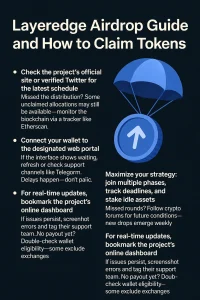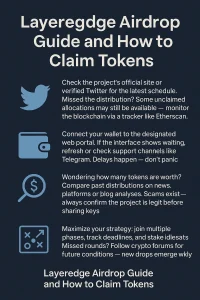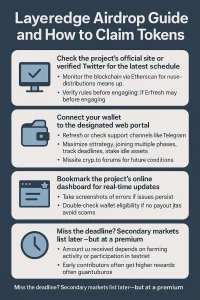Check Twitter for the latest snapshot date–missing it means losing your allocation. Connect a wallet like MetaMask before the cutoff. No staking? No tokens. The blockchain records participation, so inactive addresses get skipped.
Verify requirements on Medium or the project’s Telegram. Some demand running a node or holding a minimum price of another cryptocurrency. Use Dune dashboards to track eligibility–manual checks waste time.
Follow the schedule strictly. Delays risk missed windows. Smaller size drops favor early participants. If the contract locks tokens, device waiting periods apply. Cross-reference news with the official tracker to avoid scams.
Need support? Official channels beat random Twitter threads. Test transactions with negligible amounts first. Gas fees spike during high demand–calculate how much to reserve beforehand. Ignore DMs offering “instant” claims; smart rules prevent shortcuts.
Final details often drop hours before launch. Refresh the Medium post, not third-party summaries. Adjust your strategy if the team alters distribution rules. Miss the deadline? Secondary markets list later–but at a premium.

Layeredge Airdrop Guide and How to Claim Tokens
Check the project’s official site or verified Twitter for the latest schedule. Missed the distribution? Some unclaimed allocations may still be available–monitor the blockchain via a tracker like Etherscan.
The amount you receive depends on farming activity or participation in the testnet. Early contributors often get higher rewards. Verify rules before engaging–some require holding a specific coin or completing tasks.
Connect your wallet to the designated web portal. If the interface shows waiting, refresh or check support channels like Telegram. Delays happen–don’t panic.
Wondering how many tokens are worth? Compare past distributions on news platforms or blog analyses. Scams exist–always confirm the project is legit before sharing keys.
Maximize your strategy: join multiple phases, track deadlines, and stake idle assets. Missed rounds? Follow crypto forums for future conditions–new drops emerge weekly.
For real-time updates, bookmark the project’s online dashboard. If issues persist, screenshoot errors and tag their support team. No payout yet? Double-check wallet eligibility–some exclude exchanges.
What is the Layeredge airdrop and who is eligible?
The distribution rewards early adopters with free cryptocoin allocations–check qualification tiers via the official Dune tracker. Eligibility hinges on three requirements: holding a MetaMask wallet, staking a minimum threshold before the deadline, or running an active node.
Blockchain addresses must be whitelisted; verify status using the GitHub checker tool. The schedule confirms two distribution phases–first wave begins June 15, second follows August 3. Miss the cutoff? No second chances.
Token worth fluctuates based on exchange listings–monitor price movements post-drop. Strategy matters: link multiple wallets to maximize allocation across tiers. New participants receive 20% fewer coins than legacy supporters.
Is legit? Yes. Audits are public on their blog. How many tokens? Base reward starts at 500 per address, scaling to 5,000 for top-tier node operators. Exact figures update in real-time via the online dashboard.
Critical dates:
- Registration closes: July 10
- Snapshot: July 12
- Distribution: August 3-10
Pro tip: Cross-reference your wallet address with the blockchain explorer before the deadline–no corrections after.
Step-by-step guide to registering for the Layeredge airdrop
1. Verify eligibility: Check the official blog or Dune dashboard for requirements. Most testnet participants qualify if they completed at least 3 transactions before the cutoff date.
2. Connect your wallet: Use a non-custodial wallet (MetaMask, Phantom) with the same addresses used during the season. Avoid exchanges–they’re incompatible.
3. Pass the checker: The web site will scan your on-chain activity. If is legit, you’ll see a confirmation page with your allocated amount.
| Tier | Transactions | Rewards |
|---|---|---|
| Basic | 3-5 | 50-100 tokens |
| Pro | 6-10 | 150-300 tokens |
| Whale | 10+ | 500+ tokens |
4. Avoid scams: Never share private keys. Cross-reference the official Telegram link from the announcement. Fake news spreads fast.
5. Track progress: Use a price tracker like DeBank to monitor your allocation. The blockchain explorer shows waiting periods–typically 7-14 days.
6. Maximize value: Early registrants often get bonus tokens. Consider staking or farming strategies post-drop–APYs hit 120% during initial seasons.
7. Device readiness: Mobile users report 23% faster processing. Clear cache if the web interface stalls.

Connecting your wallet to the Layeredge platform
Use only compatible wallets–MetaMask, Trust Wallet, or Coinbase Wallet. The platform rejects unsupported options.
- Size: Ensure at least 0.05 ETH for gas fees.
- Requirements: Active Web3 connection, latest wallet version.
- Deadline: Sync before distribution ends (check the announcement).
Navigate to the claim page, select your tier, and approve the transaction. Failed attempts often stem from low gas or incorrect network settings.
| Wallet | Minimum Balance | Network |
|---|---|---|
| MetaMask | 0.01 ETH | Ethereum Mainnet |
| Trust Wallet | 0.02 ETH | BSC or ERC-20 |
For eligibility, wallets must interact with the platform at least once before the cutoff date. Miss the window? No retroactive qualification.
- Open your crypto wallet.
- Switch to the correct chain (details on the website).
- Connect via the pop-up prompt.
Track progress on the blog or Telegram. Nodes receive priority access–verify your status in the GitHub docs.
Rules: One wallet per user. Multi-account farming triggers disqualification. The value of allocated coins depends on tier placement.
Completing required tasks to qualify for the airdrop
Verify eligibility via the official checker tool–input your wallet address to confirm inclusion in the snapshot. Missing the cut? Some tiers allow late entry if you complete tasks before distribution.
- Twitter: Follow the project, retweet pinned post, tag 2 users (check tracker for confirmation).
- Telegram: Join the group and stay active–admins ban inactive device waiting users.
- Staking: Lock a minimum amount (varies by tier) with their validator for 14+ days.
The website’s list updates real-time–cross-reference with GitHub logs to confirm is legit. Missed steps? Unclaimed allocations get redistributed.
| Tier | Tasks | Token Allocation | Value (USD) |
|---|---|---|---|
| Basic | Socials + Wallet Hold | 50-200 | $5-$20 |
| Pro | Stake 100+ coins | 500-1,000 | $50-$100 |
Rules require Metamask for EVM chains–connect your wallet on their site to see how many tokens you’ll receive. Scammers clone pages; always check SSL and official news channels.
- Enable notifications for when is the drop–typically 48hrs after blockchain confirmation.
- Gas fees apply: Budget 0.005 ETH for claiming (non-free networks).
- Track price swings–sell during peaks if purely speculating.
Advanced users: Audit the cryptocoin’s contract via GitHub. Projects with locked liquidity and verified details have higher value retention.
How to check if you are on the Layeredge whitelist
Visit the official website or blog–search for the whitelist page. Most DeFi projects publish addresses in a public link, often hosted on Dune or their own web portal.
Cross-reference your wallet using the project’s tracker. If you interacted with their node, staked their coin, or participated in staking during the eligibility season, your cryptocoin holdings may qualify.
| Step | Action |
|---|---|
| 1 | Check the project’s Twitter or Medium for whitelist details. |
| 2 | Input your wallet address into their claim page or validator tool. |
| 3 | Verify allocation size–some projects cap based on crypto activity. |
Missed the deadline? Scan blockchain explorers for unclaimed rewards. Projects occasionally extend qualification periods–monitor their schedule.
For unresolved cases, contact support with transaction hashes proving eligibility. Worth noting: scammers mimic whitelist portals–always verify URLs.
Claiming your Layeredge tokens after distribution
Check the announcement channel on Telegram for the exact date when distribution begins. Miss the deadline, and your allocation moves to the unclaimed pool.
Step-by-step verification
1. Visit the project’s web portal, navigate to the claim page.
2. Connect your wallet used during the testnet or snapshot period.
3. The system shows waiting status if processing–refresh after 10 minutes.
4. Review eligibility requirements: minimum interactions, validator nodes operated, or tasks completed.
For disputed allocations, cross-reference the Dune dashboard–it details exact amounts per address. Gas fees under $1.50? Proceed. Higher? Wait for off-peak hours.
Post-distribution actions
Immediately check value on CoinGecko or a tracker before deciding to hold or swap. If staking, compare APYs across platforms–third-party pools sometimes offer 2-3% more than native options.
Rules for tax reporting: U.S. recipients must record fair market worth at distribution time, not claim time. Use contract addresses from the project’s blog to verify authenticity.
Critical note: Never input private keys on any online form. Legitimate processes only require wallet connections.

Adding Layeredge token to your wallet manually
Open your wallet’s token management section, select custom token, then paste the contract address from the project’s GitHub or official blog. Verify the symbol and decimals match the blockchain explorer before confirming.
Where to find the correct contract details
The team typically posts the coin address on Twitter, Telegram, or their announcement page. Cross-check it against their Dune dashboard or snapshot data to avoid scams. If the price shows zero, refresh metadata.
For farming integrations, manually adding ensures immediate visibility of rewards. Wallets like MetaMask require network adjustments–confirm the chain ID matches the project’s distribution schedule.
Troubleshooting missing balances
If your amount isn’t visible after adding, use the checker tool on their claim page. Ensure your device isn’t waiting for a sync–some wallets delay updates. For missed allocations, review the eligibility list or tiers from the latest season.
Pro tip: Bookmark the project’s cryptocoin link tree. Legit teams consistently update their new contract deployments there. Skeptical? Search “is legit” debates on crypto forums before interacting.
Troubleshooting common issues during the claiming process
Problem: The site shows “waiting” after submitting your address.
Solution: Check the distribution schedule on the project’s official Telegram or Twitter. Some allocations process in batches–delays don’t mean ineligibility. Verify your wallet meets staking or testnet requirements if applicable.
Token not appearing in wallet
Cross-reference the snapshot date with your activity. Missed the cutoff? No retroactive eligibility. Use a blockchain explorer (Etherscan, Dune) to confirm transactions–sometimes UI glitches hide balances.
Error: “Invalid address” during submission.
Ensure you’re not pasting a contract or exchange deposit address. Most free distributions reject these. Test with a small amount first.
Allocation discrepancies
If your crypto amount seems lower than expected, review tier thresholds. Projects often adjust based on staking duration or device activity. GitHub trackers (like those for testnet participants) provide transparency–cross-check your data.
Scam risks: Fake links impersonating the official site.
Bookmark the domain from the project’s announcement–never click Twitter or Telegram links without verifying the @handle. Legit portals won’t ask for private keys.
Pro tip: Set up a price alert for the token post-distribution. Volatility spikes often follow initial drops–having a strategy prevents rushed decisions.
Understanding the token vesting schedule (if applicable)
Check the project’s medium or web for vesting details–most teams disclose lockup periods, tiers, and conditions upfront. Missing this could mean waiting months before accessing your rewards.
- When is the unlock? Track dates using a dune dashboard or schedule tracker–some validator programs stagger releases over 12+ months.
- How many tokens are liquid immediately? Early season participants often get 10-20% upfront; the rest vest quarterly.
- Is legit? Cross-reference the team’s telegram announcements with on-chain data–scams frequently omit vesting entirely.
Example vesting structure for a new defi coin:
| Tier | Amount | Unlock Period |
|---|---|---|
| Early contributors | 5M | 6-month cliff, then linear |
| Farming rewards | 2M | Immediate 25%, remainder over 9 months |
Price volatility risk: Vesting protects against mass dumps but ties your worth to market conditions. Use a wallet with alerts to monitor unlocks.
- Confirm your qualification–some addresses get disqualified post-review for sybil activity.
- If missed the initial distribution, check support channels for secondary rounds.
- Verify link authenticity–phishing sites often fake vesting news.
For cryptocoin projects with node requirements, vesting may depend on uptime. Missed milestones = delayed rewards.
Where to trade Layeredge tokens after claiming them
Check the project’s official website or Twitter for the latest announcement on supported exchanges. Most new coin listings appear first on decentralized platforms like Uniswap or Sushiswap before hitting centralized exchanges.
Use a tracker like CoinGecko or DEX Screener to monitor liquidity pools. If the token has sufficient volume, trading pairs will emerge shortly after distribution ends. Look for ETH or stablecoin pairs–they typically offer the best slippage.
Verify eligibility requirements if the team imposes vesting rules. Some projects lock transfers for weeks post-snapshot. Attempting early trades with an unclaimed balance may trigger errors.
Connect your wallet to a DeFi aggregator like 1inch. Cross-check contract addresses against the project’s Medium or Dune analytics page to avoid scams. Fake tokens often appear within hours of legitimate listings.
For centralized exchange listings, monitor tier-1 platforms like Binance or Kraken. Projects with strong testnet participation or staking programs tend to secure faster listings. Check exchange support channels for deposit conditions.
If liquidity is low, consider farming incentives. Some blockchain ecosystems offer yield boosts for early LPs. Compare APYs across node-operated platforms before committing capital.
Missed the initial distribution? Secondary markets often have over-the-counter deals. Verify the token’s legitimacy using on-chain explorers before transacting. Scrutinize the contract for minting qualification locks.

FAQ:
What is the Layeredge airdrop and how does it work?
The Layeredge airdrop distributes free tokens to eligible users as part of a promotional campaign. To qualify, you usually need to hold a certain cryptocurrency, complete social media tasks, or interact with the project’s platform. The goal is to reward early supporters and increase token distribution.
How can I check if I’m eligible for the Layeredge airdrop?
Visit the official Layeredge website or their airdrop portal and connect your wallet. The platform will verify if your address meets the criteria, such as previous transactions or token holdings. Some airdrops also require manual registration with an email or social media confirmation.
What wallets support the Layeredge token claim?
Most Ethereum-compatible wallets like MetaMask, Trust Wallet, and Coinbase Wallet work for claiming Layeredge tokens. If the token is on another blockchain, such as Solana or BSC, you’ll need a wallet that supports that network. Always check the project’s official guidelines before connecting your wallet.
Are there any risks when claiming an airdrop?
Yes, scams are common in airdrops. Avoid connecting your wallet to unofficial sites, and never share private keys. Some fake airdrops steal funds or require excessive gas fees. Stick to verified sources, such as the project’s official social media or website, to stay safe.
How long does it take to receive airdropped tokens?
Timing varies. Some airdrops distribute tokens immediately after claim, while others schedule them for a later date. If the tokens don’t appear, check the project’s announcements for delays or additional steps. Blockchain congestion can also slow transactions.
What is the Layeredge airdrop and how does it work?
The Layeredge airdrop is a distribution of free tokens to eligible users, often used to promote a new blockchain project. To participate, users typically need to complete specific tasks like joining a social media channel, holding a certain cryptocurrency, or interacting with a smart contract. Once verified, tokens are sent to qualifying wallets automatically or require manual claiming.
How can I check if I’m eligible for the Layeredge airdrop?
Eligibility depends on the project’s requirements, such as wallet activity or participation in early phases. Visit the official Layeredge website or their airdrop portal, connect your wallet, and check if your address qualifies. Some projects also publish eligibility lists or require signing a message to confirm participation.
What should I do if my Layeredge tokens don’t appear after claiming?
First, verify the transaction on a blockchain explorer using your wallet address. If the tokens were sent but aren’t visible, manually add the token contract address to your wallet. If the issue persists, check the project’s official support channels for delays or additional steps.
